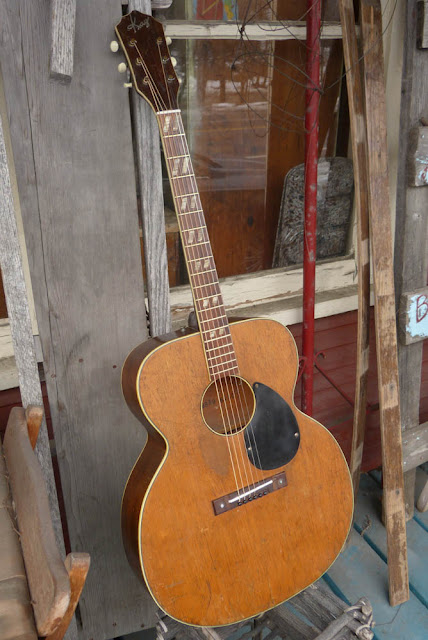1950s Kay K-22 Jumbo Flattop Guitar
This big old 17" ladder-braced brute is owned by a good customer of mine who stopped-by for some while-you-wait repairs to his guitars. This was a recent purchase of his and the seller guaranteed it as "good action" when he bought it. He'd shown me pictures of it via email and I summarily rolled my eyes because, frankly, I know old Kays.
When it arrived, of course, the neck was loose in the joint and the action was a mile high -- hence why it came here! My work on it today was to go to war with it: double-bolting the neck joint through the soundhole, a fret level/dress, new bone nut and saddle, and much resculpting of the original bridge to get the saddle slot in the right place (Kay always mounted them 1/8" too forward) and convert it to a pin-loaded type. We originally set it up per his request as a slide guitar (hair-above 3/32" action overall as in the pics) but by the time he left we'd dropped the action down so it'd be an open G fingerpicker with standard 3/32" to 1/16" bass to treble action.
After work, the guitar has a nice, wide-open, mellow tone. Like a lot of flattop Kays, the treble has some roll-off which is the reason why it went from the idea of a biting slide guitar to a fingerpicking box.
The top is solid spruce and the back and sides are laminate mahogany. It's got a mahogany neck and Brazilian rosewood headstock veneer, fretboard, and bridge. The guitar itself is original spare the pins all-around, nut, and saddle.
Oops -- we also replaced the missing Kay emblem with a repro one, too. Some of the edge headstock binding was reglued as well (typical).
This guitar has a 1 5/8" nut width and a fast, 50s/60s Gibson electric-style C-shaped profile.
A small amount of relief in the neck was dialed-out in a fret level/dress. Note the brass frets and pseudo-Gibson inlay. The long 25 3/4" scale, however, is certainly not very "Gibson."
Despite the screws, we also glued the pickguard back down for good measure.
My Dremel cut-off wheel made short work of adding a new saddle slot (in the right place) and reshaping the rear of the bridge (which was already cut-down per the original arrangement) to allow pins.
It's certainly a beater but it is crack free.
Original, bent, Kluson tuners are still working fine.














Comments